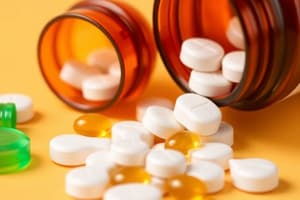Podcast
Questions and Answers
What is a common side effect of first-generation H1 antihistamines?
What is a common side effect of first-generation H1 antihistamines?
- Sedation (correct)
- Dizziness
- Heart palpitations
- Nausea
Which medical condition is NOT commonly treated with H2 blockers?
Which medical condition is NOT commonly treated with H2 blockers?
- Gastritis
- Diabetes (correct)
- Duodenal ulcer
- GERD
What unique characteristic does cimetidine have among H2 blockers?
What unique characteristic does cimetidine have among H2 blockers?
- Has the least efficacy in acid inhibition
- Strongly inhibits the cytochrome P450 system (correct)
- Causes the most side effects
- Is available only by prescription
Which of the following statements about the metabolism of H2 blockers is accurate?
Which of the following statements about the metabolism of H2 blockers is accurate?
What adverse effect can result from the use of cimetidine?
What adverse effect can result from the use of cimetidine?
What is the main purpose of inflammation?
What is the main purpose of inflammation?
Which cyclooxygenase (COX) isoform is constitutively expressed in the tissue?
Which cyclooxygenase (COX) isoform is constitutively expressed in the tissue?
Which prostaglandin is primarily associated with promoting uterine contractions?
Which prostaglandin is primarily associated with promoting uterine contractions?
What is the mechanism of action (MOA) of NSAIDs?
What is the mechanism of action (MOA) of NSAIDs?
Which of the following roles does PGE2 not play?
Which of the following roles does PGE2 not play?
What role do prostaglandins play in pain perception?
What role do prostaglandins play in pain perception?
What is the effect of TXA2 in the body?
What is the effect of TXA2 in the body?
How does reducing sensitization affect pain signals?
How does reducing sensitization affect pain signals?
What is the primary physiological role of histamine in response to tissue injury?
What is the primary physiological role of histamine in response to tissue injury?
Which histamine receptor is primarily involved in modulating the circadian cycle?
Which histamine receptor is primarily involved in modulating the circadian cycle?
What is a key feature of second-generation H1 antihistamines, such as cetirizine?
What is a key feature of second-generation H1 antihistamines, such as cetirizine?
Why is epinephrine considered the drug of choice for anaphylactic shock?
Why is epinephrine considered the drug of choice for anaphylactic shock?
What distinguishing effect do first-generation H1 blockers have compared to second-generation H1 blockers?
What distinguishing effect do first-generation H1 blockers have compared to second-generation H1 blockers?
What is the mechanism of action for mast cell stabilizers like cromolyn?
What is the mechanism of action for mast cell stabilizers like cromolyn?
Which of the following therapeutic uses is effective with both first-generation and second-generation H1 antihistamines?
Which of the following therapeutic uses is effective with both first-generation and second-generation H1 antihistamines?
H2 blockers like cimetidine primarily influence which physiological function?
H2 blockers like cimetidine primarily influence which physiological function?
Antihistamines are ineffective in treating bronchial asthma primarily because:
Antihistamines are ineffective in treating bronchial asthma primarily because:
Sedative effects are commonly associated with which group of antihistamines?
Sedative effects are commonly associated with which group of antihistamines?
What is the primary role of IL-1 released from activated macrophages?
What is the primary role of IL-1 released from activated macrophages?
What is the significance of the dose of aspirin at 81 mg/day?
What is the significance of the dose of aspirin at 81 mg/day?
Which adverse effect is more common with aspirin than with other NSAIDs?
Which adverse effect is more common with aspirin than with other NSAIDs?
What distinguishes the mechanism of action of ibuprofen from that of aspirin?
What distinguishes the mechanism of action of ibuprofen from that of aspirin?
What is a notable contraindication for the use of aspirin?
What is a notable contraindication for the use of aspirin?
Which NSAID is known to antagonize the cardioprotective effects of aspirin?
Which NSAID is known to antagonize the cardioprotective effects of aspirin?
What is a common adverse effect associated with propionic acid derivatives such as ibuprofen?
What is a common adverse effect associated with propionic acid derivatives such as ibuprofen?
Which of the following side effects can severe salicylate intoxication cause?
Which of the following side effects can severe salicylate intoxication cause?
What is the renal effect of aspirin due to inhibition of PGE2 and PGI2 production?
What is the renal effect of aspirin due to inhibition of PGE2 and PGI2 production?
What is a significant property of naproxen compared to other NSAIDs?
What is a significant property of naproxen compared to other NSAIDs?
What potential cardiovascular risk is associated with diclofenac sodium intake?
What potential cardiovascular risk is associated with diclofenac sodium intake?
What is the primary indication for ketorolac?
What is the primary indication for ketorolac?
Which side effect is commonly associated with the use of antipyretics like ketorolac?
Which side effect is commonly associated with the use of antipyretics like ketorolac?
What is a significant concern when using celecoxib in patients with renal insufficiency?
What is a significant concern when using celecoxib in patients with renal insufficiency?
How does sulindac differ from other NSAIDs in terms of gastrointestinal side effects?
How does sulindac differ from other NSAIDs in terms of gastrointestinal side effects?
Which mechanism primarily mediates sulindac's effect?
Which mechanism primarily mediates sulindac's effect?
What are common clinical uses for glucocorticoids?
What are common clinical uses for glucocorticoids?
What can prolonged use of glucocorticoids lead to in patients?
What can prolonged use of glucocorticoids lead to in patients?
What is the effect of diclofenac when combined with misoprostol?
What is the effect of diclofenac when combined with misoprostol?
Flashcards
Inflammation
Inflammation
A protective response to injury, aiming to remove damaging agents and promote healing.
COX-1
COX-1
A constitutive form of Cyclooxygenase found in tissues.
COX-2
COX-2
An induced form of Cyclooxygenase, produced during inflammation.
Prostaglandins (PGs)
Prostaglandins (PGs)
Signup and view all the flashcards
PGE2
PGE2
Signup and view all the flashcards
NSAID MOA
NSAID MOA
Signup and view all the flashcards
Nociceptors
Nociceptors
Signup and view all the flashcards
COX Inhibition
COX Inhibition
Signup and view all the flashcards
Aspirin's Low-Dose Effect
Aspirin's Low-Dose Effect
Signup and view all the flashcards
Aspirin's Kidney Effect
Aspirin's Kidney Effect
Signup and view all the flashcards
Aspirin's GI Adverse Effect
Aspirin's GI Adverse Effect
Signup and view all the flashcards
Ibuprofen as a Reversible COX Inhibitor
Ibuprofen as a Reversible COX Inhibitor
Signup and view all the flashcards
Ibuprofen's Kidney Considerations
Ibuprofen's Kidney Considerations
Signup and view all the flashcards
Reye's Syndrome
Reye's Syndrome
Signup and view all the flashcards
Cyclooxygenase (COX) Enzymes
Cyclooxygenase (COX) Enzymes
Signup and view all the flashcards
Prostaglandins
Prostaglandins
Signup and view all the flashcards
Antipyretic Effect
Antipyretic Effect
Signup and view all the flashcards
COX-2 Induction by IL-1
COX-2 Induction by IL-1
Signup and view all the flashcards
Diclofenac Sodium vs. Potassium
Diclofenac Sodium vs. Potassium
Signup and view all the flashcards
Ketorolac (Toradol) use
Ketorolac (Toradol) use
Signup and view all the flashcards
Indomethacin's Uses
Indomethacin's Uses
Signup and view all the flashcards
Sulindac Mechanism of Action
Sulindac Mechanism of Action
Signup and view all the flashcards
COX-2 Selective NSAIDs (Celecoxib)
COX-2 Selective NSAIDs (Celecoxib)
Signup and view all the flashcards
Steroid Anti-inflammatory Drugs (SAIDs) side effects
Steroid Anti-inflammatory Drugs (SAIDs) side effects
Signup and view all the flashcards
Autacoids definition
Autacoids definition
Signup and view all the flashcards
Histamine storage & release
Histamine storage & release
Signup and view all the flashcards
Diclofenac Side Effects
Diclofenac Side Effects
Signup and view all the flashcards
NSAIDs General Info
NSAIDs General Info
Signup and view all the flashcards
H1 Antihistamine Effect
H1 Antihistamine Effect
Signup and view all the flashcards
H1 Antihistamine Side Effects
H1 Antihistamine Side Effects
Signup and view all the flashcards
Parietal Cells and HCl
Parietal Cells and HCl
Signup and view all the flashcards
H2 Blocker MOA
H2 Blocker MOA
Signup and view all the flashcards
Cimetidine & Drug Interactions
Cimetidine & Drug Interactions
Signup and view all the flashcards
Histamine Release
Histamine Release
Signup and view all the flashcards
Histamine Receptor Types
Histamine Receptor Types
Signup and view all the flashcards
What does H1 do?
What does H1 do?
Signup and view all the flashcards
What does H2 do?
What does H2 do?
Signup and view all the flashcards
What does H3 do?
What does H3 do?
Signup and view all the flashcards
What does H4 do?
What does H4 do?
Signup and view all the flashcards
Epinephrine's Role in Histamine Counteraction
Epinephrine's Role in Histamine Counteraction
Signup and view all the flashcards
Mast Cell Stabilizers
Mast Cell Stabilizers
Signup and view all the flashcards
H1 Blockers: First vs. Second Gen
H1 Blockers: First vs. Second Gen
Signup and view all the flashcards
H2 Blockers
H2 Blockers
Signup and view all the flashcards
Study Notes
Inflammation and NSAIDs
- Inflammation is a protective response to injury, aiming to remove damaging agents and promote healing.
- COX-1 is a constitutive enzyme found in tissues.
- COX-2 is induced by inflammatory cytokines.
- Prostaglandins (PGs) are not pain initiators, but sensitize pain receptors.
- Prostaglandins have diverse effects, including vasodilation, bronchodilation, and influencing gastric function. Examples include PGE2 and PGF2α.
- Thromboxane A2 (TXA2) induces platelet aggregation and vasoconstriction.
- PGI2 inhibits platelet aggregation and causes vasodilation. A balance between TXA2 and PGI2 is needed.
- Nociceptors convey pain signals to the brain.
- NSAIDs inhibit cyclooxygenases (COX) enzymes, reducing prostaglandin production, thus decreasing pain sensitivity.
- COX-1 has housekeeping functions, and COX-2 expression is triggered by inflammatory factors, such as TNF-α and IL-1.
- NSAIDs can reduce fever (antipyretic action).
- IL-1 is released by activated macrophages, leading to COX-2 induction in the brain and subsequent fever response.
Aspirin (ASA)
- High doses (325 mg) have anti-inflammatory, analgesic, and antipyretic actions.
- Low doses (81 mg) reduce cardiovascular events (MI, stroke) and colon cancer recurrence risk.
- Irreversibly inhibits TXA2 at low doses, prolonging the anti-platelet effect. This effect lasts for the lifespan of the platelet (3-7 days).
- This anticoagulant effect decreases thrombus formation.
- It reduces PGE2 and PGI2 leading to renal vasoconstriction. This can cause kidney damage and is contraindicated for patients with impaired kidney function (<30 GFR).
- Adverse effects include gastric distress, nausea, vomiting, microscopic bleeding, prolonged bleeding time, and potentially respiratory depression at high doses.
- Reye's syndrome risk is associated with aspirin use after viral infections in children, which is fatal.
- Salicylism (mild toxicity) presents with symptoms like nausea, vomiting, hyperventilation, headache, dizziness, and tinnitus.
- Severe toxicity can cause metabolic acidosis, coma, and vascular collapse.
- Contraindicated in pregnancy and breastfeeding due to excretion in breast milk.
Propionic Acid Derivatives (e.g., Ibuprofen)
- Ibuprofen has anti-inflammatory, analgesic, and antipyretic activity.
- It's a reversible COX inhibitor, making it more potent than aspirin as an anti-inflammatory agent.
- Rapid oral absorption and a shorter half-life (1-2 hours).
- Highly bound to plasma proteins, requiring higher doses for effect.
- Excreted via kidneys as metabolites, thus contraindicated for patients with kidney dysfunction.
- Clinical uses include analgesia, antipyrexia, anti-inflammation, and acute gouty arthritis.
- Available as oral preparations, topical creams, liquids, and intravenous formulations.
- Adverse effects include gastric upset, fluid retention, and hypersensitivity reactions.
- Rare hematologic effects (agranulocytosis, aplastic anemia) can occur.
Heteroaryl Acetic Acids (e.g., Diclofenac)
- Diclofenac is a potent anti-inflammatory agent, more potent than some other NSAIDs.
- Clinical applications cover various inflammatory conditions, musculoskeletal pain, dysmenorrhea, and acute gout.
- Available as sodium or potassium salts. Sodium salt can cause fluid retention. Potassium salt is preferable for cardiovascular patients.
- Diclofenac combined with Misoprostol decreases GI ulceration but may cause diarrhea. Combined with Omeprazole can help prevent bleeding.
- Common side effects include gastric upset, renal impairment, and elevated liver enzymes.
Heteroaryl Acetic Acids (e.g., Ketorolac)
- Ketorolac is a potent analgesic and anti-inflammatory agent.
- Primarily used for short-term management of acute pain rather than long-term inflammation.
- Suitable for post-operative care, spine pain, and various inflammatory conditions.
- Oral and ophthalmic forms are available.
- Administration should be limited to <5 days due to side effects.
- Common side effects include nausea, vomiting, diarrhea, stomach pain, and headache.
Acetic Acid Derivatives (e.g., Indomethacin)
- Indomethacin is a potent anti-inflammatory agent.
- Used for chronic musculoskeletal pain, patent ductus arteriosus closure, and ophthalmic conditions.
- Can be used for uveitis.
- High doses can be toxic. Also used for Gout and suppression of uterine contractions.
- Absorbed orally, largely bound to plasma proteins.
Sulindac
- Sulindac is a prodrug, which is metabolized to an active compound, which inhibits COX-1 and COX-2.
- May have fewer GI side effects than other NSAIDs due to enterohepatic circulation.
COX-2 Selective NSAID (e.g., Celecoxib)
- Celecoxib selectively inhibits COX-2.
- Used for osteoarthritis, but not as an analgesic.
- Lowers risks for gastric upset compared to traditional NSAIDs.
- Significant risk in increasing cardiovascular risks, specifically myocardial infarctions and strokes.
- Contraindicated for patients with severe renal insufficiency.
Steroidal Anti-Inflammatory Drugs (SAIDs)
- SAIDs (Corticosteroids) are potent anti-inflammatory agents.
- Used in various conditions, including adrenal insufficiency, arthritis, and allergic reactions.
- Significant side effects include increased susceptibility to infections, delayed healing, osteoporosis, growth retardation, and Cushing syndrome.
Autacoids (Histamine, Antihistamines)
- Autacoids act as local hormones. Include histamine, serotonin, prostaglandins, and vasoactive peptides.
- Histamine mediates allergic and inflammatory reactions, gastric acid secretion, and brain neurotransmission.
- It's stored in mast cells and released by tissue injury or allergic reactions.
- Histamine receptors (H1, H2, H3, H4) mediate diverse effects.
- Histamine antagonists (antihistamines) block histamine receptors to reduce allergic responses.
- First-generation antihistamines often cause sedation and other side effects.
- Second-generation antihistamines are less sedating and have fewer autonomic effects. H2 blockers (e.g., cimetidine) reduce gastric acid production and used for ulcers and GERD. Histamine receptor blockers (H1 and H2) reduce effects of histamine in body.
Studying That Suits You
Use AI to generate personalized quizzes and flashcards to suit your learning preferences.



